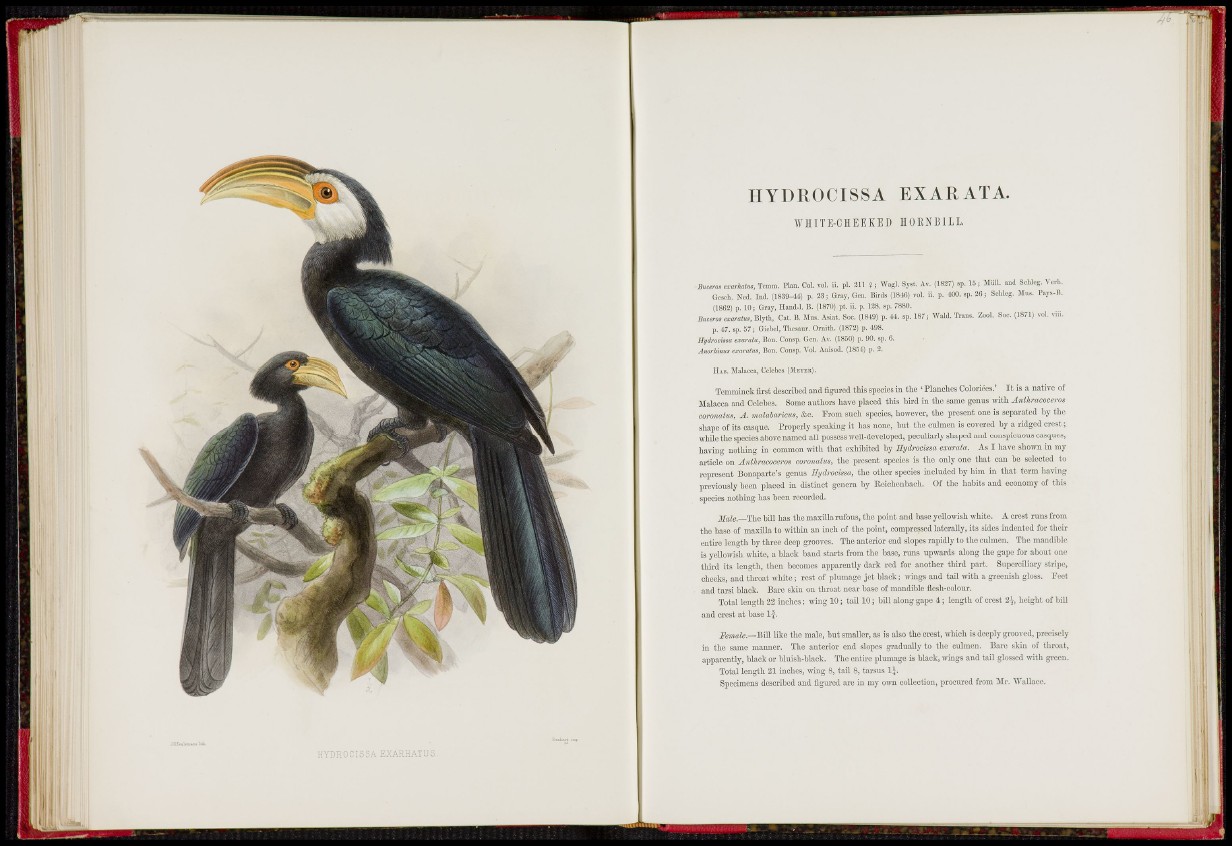
H T D K Ü C I S S A EXAR'JAT'JS
1 ,ii'
I I Y D R O C I S S A E X A R A T A .
W n i T E - C H E E K E D EOENBILL.
Ab
Buceros txarhaiu$, Temm. Plan. Col. vol. ii. pl. al l 2 ; Wagl. Syst. Av. (1827) sp. 15 ; Müll, and Sclilcg, Vurli.
Gesell. Ned. Ind. (1839-44) p. 23; Gray, Geu. Birds (18-16) vol. ii, p. 400. sp. 2G; Schlog, Mus. Pays-».
(1862) p. 10; Gray, IIand-1. B. (1870) pt. ii. p. 1.28. sp. 7880.
BateroB eaaraius, Blytli, Cat. 15. Mus. Asiat. Soo. (1849) p. 44. sp, 187; Wald. Trans. Zool. Soc, (1871) vol. viii.
p. 47. sp. 57; Giebel, Thesaur, Ornith. (1872) p, 498,
HydrocUsa exarata, Bon. Consp. Gen. Ar, (1850) p. 90. sp. 6.
Anorhinus exaratus, Bon. Consp, Vol. Anisod. (1851) p. 2.
ILvij. Malacca, CeleljBs (MEYEII).
Temmiûck first dcscrited and figured this species in the ' Planches Coloriées.' It is a native of
Malacca and Celehes. Some authors have placed this hird in the same genus with Anthracoceros
coronatus, A. malabariciis, &c. Prom such species, however, the present one is separated by the
shape of its casque. Properly speaking it has none, but the culmen is covcred by a ridged crest ;
whüe the species above named all possess well-dcvcloped, peculiarly shaped and conspicuous casques,
having nothing in common with that exhibited by Jlydrocissa exarala. As I have shown in my
article on Anthracoceros coronatus, the present species is the only one that can bo selected to
represent Bonaparte's genus Ilydrocissa, the other species included by him in that term having
previously been placed in distinct genera by Eeiclienbach. Of the habits and cconomy of this
species nothing has been recorded.
Male.—Tïvi bill has the maxilla rufous, the point and base yellowish white. A crest runs from
the base of maxilla to within an inch of the point, compressed laterally, its sides indented for their
entii-e length by three deep grooves. The anterior end slopes rapidly to the culmen. The mandible
is yellowish white, a black band starts from the base, runs upwards along the gape for about one
third its length, then bccomes apparently dark red for another third part. Superciliary stripe,
cheeks, and throat white ; rest of plumage jet black ; wings and tail with a greenish gloss. Pcct
and tarsi black. Bare skin on throat near base of mandible flesh-colour.
Total length 22 inches ; wing 10 ; tail 10 ; bill along gape 4 ; length of crest 2}, height of bill
and crest at base
ibmate.—Bill like the male, but smaller, as is also the crcst, which is deeply grooved, precisely
in the same manner. The anterior end slopes gradually to the culmen. Bare skin of throat,
apparently, black or bluish-blaek. The entire plumage is black, wings and tail glossed with green.
Total length 21 inchcs, wing 8, tail 8, tarsus
Specimens described and figured are in my own collection, procured from i l r . "Wallace.
I- I